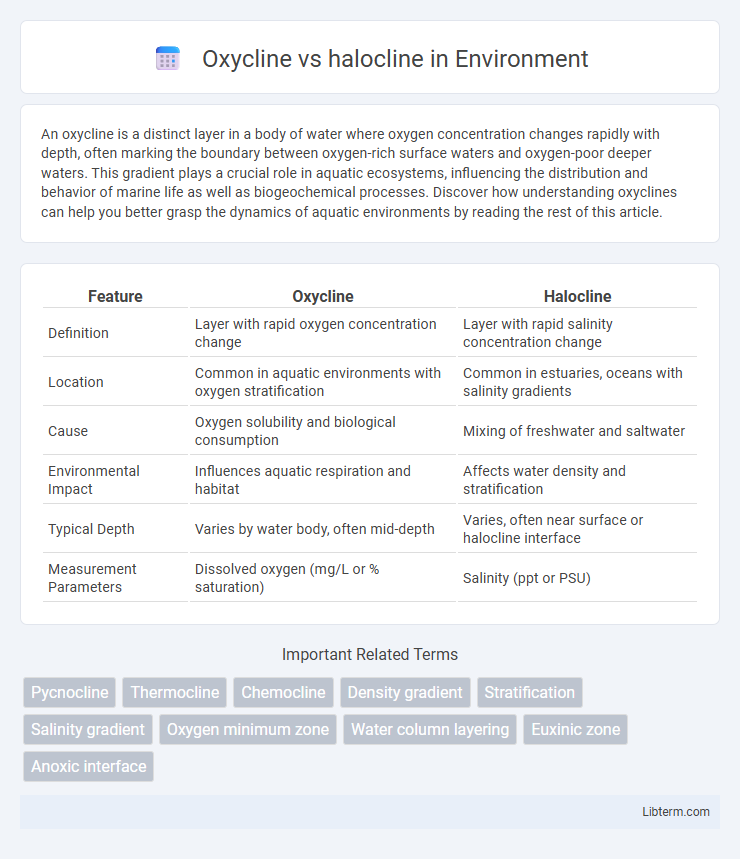An oxycline is a distinct layer in a body of water where oxygen concentration changes rapidly with depth, often marking the boundary between oxygen-rich surface waters and oxygen-poor deeper waters. This gradient plays a crucial role in aquatic ecosystems, influencing the distribution and behavior of marine life as well as biogeochemical processes. Discover how understanding oxyclines can help you better grasp the dynamics of aquatic environments by reading the rest of this article.
Table of Comparison
| Feature | Oxycline | Halocline |
|---|---|---|
| Definition | Layer with rapid oxygen concentration change | Layer with rapid salinity concentration change |
| Location | Common in aquatic environments with oxygen stratification | Common in estuaries, oceans with salinity gradients |
| Cause | Oxygen solubility and biological consumption | Mixing of freshwater and saltwater |
| Environmental Impact | Influences aquatic respiration and habitat | Affects water density and stratification |
| Typical Depth | Varies by water body, often mid-depth | Varies, often near surface or halocline interface |
| Measurement Parameters | Dissolved oxygen (mg/L or % saturation) | Salinity (ppt or PSU) |
Introduction to Water Column Stratification
Oxycline and halocline represent distinct layers within water column stratification characterized by sharp gradients in dissolved oxygen and salinity, respectively. The oxycline indicates a rapid decrease in oxygen concentration with depth, often influencing marine life distribution and biogeochemical processes. In contrast, the halocline marks a significant salinity change, impacting water density and vertical mixing in oceans and lakes.
Defining Oxycline and Halocline
Oxycline refers to the layer in a water column where there is a rapid decrease in dissolved oxygen concentration with depth, typically found in oceans and lakes. Halocline is the zone where there is a sharp change in salinity that separates different water masses, influencing density and stratification. These clines play crucial roles in marine and freshwater ecosystems by affecting oxygen availability and water mass mixing.
Causes of Oxycline Formation
Oxycline formation results primarily from variations in oxygen concentration driven by biological activity and water column stratification, often occurring in areas with significant organic matter decomposition by microbes that consume oxygen. This contrasts with haloclines, which form due to differences in salinity caused by the mixing of freshwater and seawater. The oxycline typically develops where ventilation is limited, and oxygen consumption exceeds replenishment, creating a sharp gradient in dissolved oxygen levels.
Factors Influencing Halocline Development
Halocline development is primarily influenced by freshwater input, evaporation rates, and oceanic currents, which create distinct salinity gradients in the water column. Variations in precipitation and river discharge lead to stratification, intensifying the halocline where less saline surface water overlays denser, saltier deep water. Temperature fluctuations and wind-driven mixing can modify these salinity layers, but the halocline remains distinct from the oxycline, which is governed mainly by oxygen levels and biological activity.
Physical Processes Behind Each Gradient
Oxycline represents a vertical zone in a water body where oxygen concentration drastically changes due to microbial respiration and limited mixing, often influenced by temperature and biological activity. Halocline is a layer characterized by sharp salinity gradients caused by the mixing of freshwater and seawater, driven primarily by evaporation, precipitation, and freshwater inflows affecting water density and stratification. Both gradients result from distinct physical processes impacting water column stability and mixing dynamics, with oxycline linked to biogeochemical reactions and halocline to hydrological and salinity-driven density differences.
Ecological Impacts of Oxycline vs Halocline
Oxycline zones, characterized by sharp oxygen gradients, critically influence aquatic ecosystems by limiting aerobic organisms to oxygen-rich layers, thereby affecting species distribution and metabolic rates. Haloclines, defined by abrupt salinity changes, create stratified habitats that restrict vertical mixing, impacting nutrient cycling and species adaptation in estuarine and marine environments. The ecological impacts of oxyclines often involve hypoxia-induced stress, while haloclines drive salinity-dependent biodiversity patterns and influence the stability of aquatic food webs.
Measurement Methods and Technologies
Oxycline measurement primarily utilizes dissolved oxygen sensors such as Clark-type electrodes, optodes, and voltammetric sensors to accurately detect rapid changes in oxygen concentration with depth, often deployed via CTD (Conductivity, Temperature, Depth) rosettes. Halocline detection relies on salinity profiling instruments including conductivity sensors and refractometers integrated into CTD platforms, allowing precise mapping of salt concentration gradients in aquatic environments. Advanced autonomous underwater vehicles (AUVs) and remote sensing technologies enhance spatial and temporal resolution for both oxycline and halocline studies, providing critical data for oceanographic and limnological research.
Oxycline and Halocline in Different Aquatic Environments
Oxycline refers to the vertical zone in aquatic environments where oxygen concentration rapidly decreases with depth, while halocline denotes the layer where salinity changes sharply. In freshwater lakes, oxyclines are prominent due to oxygen consumption by decomposition, whereas haloclines are more common in estuaries and marine settings where freshwater mixes with seawater. Both oxyclines and haloclines influence aquatic species distribution, nutrient cycling, and water column stability across diverse aquatic ecosystems.
Implications for Marine Life and Chemistry
Oxyclines mark rapid decreases in dissolved oxygen, affecting aerobic marine organisms by creating hypoxic zones that limit habitat range and alter species interactions. Haloclines exhibit sharp salinity gradients, influencing water density and stratification, which impact nutrient mixing and marine organism distribution. Both oxyclines and haloclines drive chemical gradients that regulate biogeochemical cycles, oxygen availability, and biodiversity in marine ecosystems.
Summary: Key Differences and Similarities
Oxycline and halocline both represent vertical gradients in oceanic water properties, with oxycline marking a rapid decrease in oxygen concentration and halocline indicating a sharp change in salinity. Both layers influence marine ecosystems by affecting the distribution of marine species and biochemical processes, often occurring at different depths due to distinct environmental factors. Understanding these clines aids in studying ocean stratification, nutrient cycling, and habitat zones in marine science.
Oxycline Infographic

 libterm.com
libterm.com